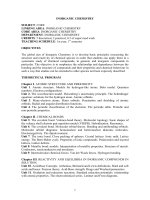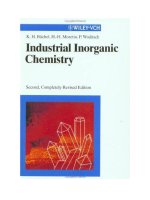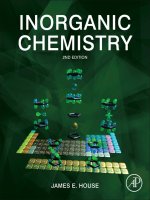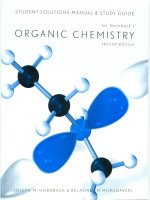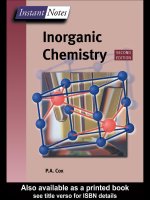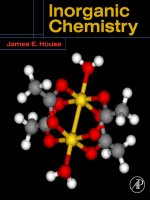Inorganic chemistry (2nd edition)
Bạn đang xem bản rút gọn của tài liệu. Xem và tải ngay bản đầy đủ của tài liệu tại đây (32.07 MB, 848 trang )
Inorganic Chemistry
This page intentionally left blank
Inorganic Chemistry
Second Edition
James E. House
Illinois Wesleyan University
and Illinois State University
AMSTERDAM
BOSTON
HEIDELBERG
LONDON
NEW YORK
OXFORD
PARIS
SAN DIEGO
SAN FRANCISCO
SINGAPORE
SYDNEY
TOKYO
Academic Press is Imprint of Elsevier
Elsevier
225 Wyman Street, Waltham, MA 02451, USA
The Boulevard, Langford Lane, Kidlington, Oxford OX5 1GB, UK
First edition 2008
Second edition 2013
Copyright Ó 2013, 2008 Elsevier Inc. All rights reserved.
No part of this publication may be reproduced, stored in a retrieval system or transmitted in any form or by
any means electronic, mechanical, photocopying, recording or otherwise without the prior written permission
of the publisher
Permissions may be sought directly from Elsevier’s Science & Technology Rights Department in Oxford,
UK: phone (+44) (0) 1865 843830; fax (+44) (0) 1865 853333; email: Alternatively
you can submit your request online by visiting the Elsevier web site at />and selecting Obtaining permission to use Elsevier material
Notice
No responsibility is assumed by the publisher for any injury and/or damage to persons or property as a matter
of products liability, negligence or otherwise, or from any use or operation of any methods, products, instructions
or ideas contained in the material herein. Because of rapid advances in the medical sciences, in particular,
independent verification of diagnoses and drug dosages should be made
Library of Congress Cataloging-in-Publication Data
A catalog record for this book is available from the Library of Congress
Library of Congress Cataloging-in-Publication Data
House, J. E.
Inorganic chemistry / James House. e 2nd ed.
p. cm.
Includes bibliographical references and index.
1. Chemistry, Inorganic e Textbooks. I. Title.
QD151.5.H68 2013
546–dc23
2012017867
ISBN: 978-0-12-385110-9
For information on all Elsevier publications
visit our website at www.store.elsevier.com
Printed and bound in China
1213 111098765432
Contents
PREFACE TO THE SECOND EDITION xi
PREFACE TO THE FIRST EDITION xii
PART 1 Structure of Atoms and Molecules 1
CHAPTER 1 Light, Electrons, and Nuclei 3
1.1 Some Early Experiments in Atomic Physics 3
1.2 The Nature of Light 7
1.3 The Bohr Model 11
1.4 ParticleeW
ave Duality 14
1.5 Electronic Properties of Atoms 16
1.6 Nuclear Binding Energy 21
1.7 Nuclear Stability 23
1.8 Types of Nuclear Decay 25
1.9 Predicting Decay Modes 28
CHAPTER 2 Basic Quantum Mechanics and Atomic Structure 33
2.1 The Postulates 33
2.2 The Hydrogen Atom 40
2.3 The Helium Atom 45
2.4 Slater Wave Functions 47
2.5 Electron Configurations 49
2.6 Spectroscopic States 54
CHAPTER 3 Covalent Bonding in Diatomic Molecules 61
3.1 The Basic Ideas of Molecular Orbital Methods 61
3.2 The H
þ
2
and H
2
Molecules 69
3.3 Diatomic Molecules of Second-Row Elements 71
3.4 Photoelectron Spectroscopy 77
3.5 Heteronuclear Diatomic Molecules 79
3.6 Electronegativity 82
3.7 Spectroscopic States for Molecules 85
v
CHAPTER 4 A Survey of Inorganic Structures and Bonding 89
4.1 Structures of Molecules Having Single Bonds 89
4.2 Resonance and Formal Charge 99
4.3 Complex Structures: A Preview of Coming Attractions 111
4.4 Electron-Deficient Molecules 119
4.5 Structures Having Unsaturated Rings 121
4.6 Bond Energies 123
CHAPTER 5 Symmetry and Molecular Orbitals 129
5.1 Symmetry Elements 129
5.2 Orbital Symmetry 137
5.3 A Brief Look at Group Theory 139
5.4 Construction of Molecular Orbitals 144
5.5 Orbitals and Angles 150
5.6 Simple Calculations Using the Hückel Method 152
PART 2 Condensed Phases 167
CHAPTER 6 Dipole Moments and Intermolecular Interactions 169
6.1 Dipole Moments 169
6.2 DipoleeDipole
Forces 174
6.3 Dipole-Induced Dipole Forces 176
6.4 London (Dispersion) Forces 177
6.5 The van der Waals Equation 181
6.6 Hydrogen Bonding 183
6.7 Cohesion Energy and Solubility Parameters 192
6.8 Solvatochromism 196
CHAPTER 7 Ionic Bonding and Structures of Solids 201
7.1 Energetics of Crystal Formation 201
7.2 Madelung Constants 205
7.3 The Kapustinskii Equation 209
7.4 Ionic Sizes and Crystal Environments 210
7.5 Cr ystal Structures 213
7.6 Solubility of Ionic Compounds 219
7.7 Proton and Electron Affinities 224
7.8 Structures of Metals 227
7.9 Defects in Crystals 230
7.10 Phase Transitions in Solids 233
7.11 Heat Capacity 234
7.12 Hardness of Solids 237
vi
Contents
CHAPTER 8 Dynamic Processes in Inorganic Solids 243
8.1 Characteristics of Solid-State Reactions 243
8.2 Kinetic Models for Reactions in Solids 245
8.3 Thermal Methods of Analysis 253
8.4 Effects of Pressure 254
8.5 Reactions in Some Solid Inorganic Compounds 256
8.6 Phase Transitions 258
8.7 Reactions at Interfaces 262
8.8 Diffusion in Solids 263
8.9 Sintering
265
8.10 Drift and Conductivity 267
PART 3 Acids, Bases, and Solven ts 271
CHAPTER 9 AcideBase Chemistry 273
9.1 Arrhenius Theory 273
9.2 BrønstedeLowr
y Theory 276
9.3 Factors Affecting the Strength of Acids and Bases 279
9.4 AcideBase
Character of Oxides 284
9.5 Proton Affinities 286
9.6 Lewis Theory 288
9.7 Catalytic Behavior of Acids and Bases 292
9.8 The HardeSoft
Interaction Principle (HSIP) 296
9.9 Electronic Polarizabilities 305
9.10 The Drago Four-Parameter Equation 306
CHAPTER 10 Chemistry in Nonaqueous Solvents 313
10.1 Some Common Nonaqueous Solvents 313
10.2 The Solvent Concept 314
10.3 Amphoteric Behavior 316
10.4 The Coordination Model 317
10.5 Chemistry in Liquid Ammonia 318
10.6 Liquid Hydrogen Fluoride 324
10.7 Liquid Sulfur Dioxide 326
10.8 Superacids 330
PART 4 Chemistry of the Elements 335
CHAPTER 11 Chemistry of Metallic Elements 337
11.1 The Metallic Elements 337
11.2 Band Theory 338
viiContents
11.3 Groups IA and IIA Metals 341
11.4 Zintl Phases 349
11.5 Aluminum and Beryllium 351
11.6 The First-Row Transition Metals 353
11.7 Second- and Third-Row Transition Metals 355
11.8 Alloys 357
11.9 Chemistry of Transition Metals 360
11.10 The Lanthanides 367
CHAPTER 12 Organometallic Compounds of the Main Group Elements 375
12.1 Preparation of Organometallic Compounds 376
12.2 Organometallic Compounds of Group IA Metals 378
12.3 Organometallic Compounds of Group IIA Metals 380
12.4 Organometallic Compounds of Group IIIA Metals 383
12.5 Organometallic Compounds of Group IVA Metals 387
12.6 Organometallic Compounds of Group VA Elements 388
12.7 Organometallic Compounds of Zn, Cd, and Hg 389
CHAPTER 13 Chemistry of Nonmetallic Elements I. Hydrogen, Boron, Oxygen, and
Carbon 393
13.1 Hydrogen 393
13.2 Boron
400
13.3 Oxygen 411
13.4 Carbon 420
CHAPTER 14 Chemistry of Nonmetallic Elements II. Groups IVA and VA 439
14.1 The Group IVA Elements 439
14.2 Nitrogen 456
14.3 Phosphorus, Arsenic, Antimony, and Bismuth 471
CHAPTER 15 Chemistry of Nonmetallic Elements III. Groups VIAeVIIIA 499
15.1 Sulfur, Selenium, and Tellurium 499
15.2 The Halogens 520
15.3 The Noble Gases 538
PART 5 Chemistry of Coordination Compounds 551
CHAPTER 16 Introduction to Coordination Chemistry 553
16.1 Structures of Coordination Compounds 553
16.2 MetaleLigand
Bonds 557
16.3 Naming Coordination Compounds 559
16.4 Isomerism 561
16.5 A Simple Valence Bond Description of Coordinate Bonds 568
viii
Contents
16.6 Magnetism 572
16.7 A Survey of Complexes of First-Row Metals 574
16.8 Complexes of Second- and Third-Row Metals 576
16.9 The 18-Electron Rule 576
16.10 Back Donation 580
16.11 Complexes of Dinitrogen, Dioxygen, and Dihydrogen 585
CHAPTER 17 Ligand Fields and Molecular Orbitals 591
17.1 Splitting of d Orbital Energies in Octahedral Fields 591
17.2 Splitting of d Orbital
Energies in Fields of Other Symmetry 594
17.3 Factors Affecting
D
598
17.4 Consequences of Crystal Field Splitting 600
17.5 JahneT
eller Distortion 603
17.6 Spectral Bands 604
17.7 Molecular Orbitals in Complexes 606
CHAPTER 18 Interpretation of Spectra 617
18.1 Splitting of Spectroscopic States 617
18.2 Orgel Diagrams 621
18.3 Racah Parameters and Quantitative Methods 624
18.4 The Nephelauxetic Effect 627
18.5 TanabeeSugano
Diagrams 629
18.6 The Lever Method 633
18.7 Jørgensen’s
Method 636
18.8 Charge Transfer Absorption 637
18.9 Solvatochromism 639
CHAPTER 19 Composition and Stability of Complexes 643
19.1 Composition of Complexes in Solution 643
19.2 Job’s
Method of Continuous Variations 645
19.3 Equilibria Involving Complexes 647
19.4 Distribution Diagrams 652
19.5 Factors Affecting the Stability of Complexes 655
CHAPTER 20 Synthesis and Reactions of Coordination Compounds 665
20.1 Synthesis of Coordination Compounds 665
20.2 Substitution Reactions in Octahedral Complexes 671
20.3 Ligand Field Effects 678
20.4 Acid-Catalyzed Reactions of Complexes 681
20.5 Base-Catalyzed Reactions of Complexes 682
20.6 The Compensation Effect 684
20.7 Linkage Isomerization 685
ixContents
20.8 Substitution in Square Planar Complexes 687
20.9 The Trans Effect 690
20.10 Electron Transfer Reactions 694
20.11 Reactions in Solid Coordination Compounds 697
CHAPTER 21 Complexes Containing MetaleCarbon and MetaleMetal Bonds 707
21.1 Binar y Metal Carbonyls 707
21.2 Structures of Metal Carbonyls 711
21.3 Bonding of Carbon Monoxide to Metals 712
21.4 Preparation of Metal Carbonyls 715
21.5 Reactions of Metal Carbonyls 716
21.6 Structure and Bonding in MetaleAlkene
Complexes 721
21.7 Preparation of MetaleAlkene
Complexes 727
21.8 Chemistry of Cyclopentadienyl and Related Complexes 728
21.9 Bonding in Ferrocene 732
21.10 Reactions of Ferrocene and other Metallocenes 735
21.11 Complexes of Benzene and Related Aromatics 738
21.12 Compounds Containing MetaleMetal
Bonds 741
CHAPTER 22 Coordination Compounds in Catalysis 747
22.1 Elementary Steps in Catalytic Processes 748
22.2 Homogeneous Catalysis 761
CHAPTER 23 Bioinorganic Chemistry 773
23.1 What Metals Do in Some Living Systems 773
23.2 Cytotoxicity of Some Metal Compounds 784
23.3 Antimalarial Metallodrugs 792
APPENDIX A: Ionization Energies 797
APPENDIX B: Character Tables for Selected Point Groups 801
INDEX
807
x
Contents
Preface to the Second Edition
The developme nt of inorganic continues at an astonishing pace, and the number of journal pages
devoted annually to the field continues to increase. Since the publication of the first edition of this
book, exciting results have been obtained in many areas, especially in the application of inorganic
compounds in medicine.
The present edition continues the same format as the first with five major areas that constitute atomic
and molecular structure; condensed phases; acids, bases, and solvents; chemistry of the elements; and
chemistry of coordination compounds. Although the structure of the book has not been changed, there
are some signifi cant modifications. First, the coverage of superacids in Chapter 10 has been expanded in
order to reflect the increasing utilization of these materials in inorganic chemistry. Second, a new
chapter on bioinorganic chemistry has been added, with numerous illustrations from the recent liter-
ature that describe the use of metal complexes in medicine. Third, the coverage of catalysis by complexes
has been expanded with new material on mechanisms. Fourth, the entire manuscript has been edited to
enhance clarity of presentation. The judicious use of color illustrations is also new to this edition.
Finally, a significant number of additional end of chapter questions and problems have been added.
Although there have been substantial changes in the coverage from the first edition, flexibility in the
order of presentation remains. After the introductory chapters on atomic and molecular structure, the
nature of inorganic condensed phases is described with a theme of understanding properties of such
materials. Chapter 8 deals with dynamic processes in solids because of the importance of the topic in
many industrial processes.
Explanations do not exist for all observations in the behavior of inorganic compo unds. Conse-
quently, throughout the text there are instances mentioned which illustrate unanswered questions in
science. It is hoped that some of these might generate an interest that would cause the reader to pursue
further study in inorganic chemistry.
The author wishes to thank all of those students who have used the first edition and pointed out
errors. Their contribution to the preparation of the second edition is gratefully acknowledged. The
author also wishes to thank his wife, Kathleen, for enduring yet another long project.
xi
Preface to the First Edition
No single volume, certainly not a textbook, can come close to including all of the important topics in
inorganic chemistry. The field is simply t oo broad in scope and it is growing at a rapid pace. Inorganic
chemistry textbooks refl ect a great deal of work and the results of the many choices that authors must
make as to what to include and what to leave out. Writers of textbooks in chemistry bring to the task
backgrounds that reflect their research interests, the schools they attended, and their personalities. In
their writing, authors are really saying “this is the field as I see it.” In these regards, this book is similar to
others.
When teaching a course in inorganic chemistry, certain core topics are almost universally included. In
addition, there are numerous peripheral areas that may be included at certain schools but not at others
depending on the interests and specialization of the person teaching the course. The course content may
even change from one semester to the next. The effort to produce a textbook that presents coverage of
a wide range of optional material in addition to the essential topics can result in a textbook for a one
semester course that contains a thousa nd pages. Even a “concise” inorganic chemistry book can be
nearly this long. This book is not a survey of the literature or a research monograph. It is a textbook that
is intended to provide the background necessary for the reader to move on to those more advanced
resources.
In writing this book, I have attempted to produce a concise textbook that meets several objectives.
First, the topics included were selected in order to provide essential information in the major areas of
inorganic chemistry (molecular structure, acidebase chemistry, coordination chemistry, ligand field
theory, solid-state chemistry, etc.). These topics form the basis for competency in inorganic chemistry at
a level commensurate with the one semester course taught at most colleges and universities.
When painting a wall, better coverage is assured when the roller passes over the same area several
times from different directions. It is the opinion of the author that this technique works well in
teaching chemistry. Therefore, a second objective has been to stress fundamental principles in the
discussion of several topics. For example, the hardesoft interaction principle is employed in
discussion of acidebase chemistry, stability of complexes, solubility, and predicting reaction prod-
ucts. Third, the presentation of topics is made with an effort to be clear and concise so that the book
is portable and user friendly. This book is meant to present in convenient form a readable account of
the essentials of inorganic chemistry that can serve as both as a textboo k for a one semester course,
upper-level course and as a guide for self study. It is a textbook not a review of the literature or
a research monograph. There are few references to the original literature, but many of the advanced
books and monographs are cited.
xii
Although the material contained in this book is arranged in a progressive way, there is flexibility in
the order of presentation. For students, who have a good grasp of the basic principles of quantum
mechanics and atomic structure, Chapters 1 and 2 can be given a cursory reading but not included in
the required course material. The chapters are included to provide a resource for review and self study.
Chapter 4 presents an overview of structural chemistry early so the reader can become familiar with
many types of inorganic structures before taking up the study of symmetry or chemistry of specific
elements. Structures of inorganic solids are discussed in Chapter 7, but that material could easily be
studied before Chapters 5 or 6. Chapter 6 contains material dealing with intermolecular forces and
polarity of molecules because of the importance of these topics when interpreting properties of
substances and their chemical behavior. In view of the importance of the topic, especially in industrial
chemistry, this book inc ludes material on rate processes involving inorganic compounds in the solid
state (Chapter 8). The chapter begins with an overview of some of the important aspects of reactions in
solids before considering phase transitions and reactions of solid coordination compounds.
It should be an acknowledged fact that no single volume can present the descriptive chemistry of all
the elements. Some of the volumes that attempt to do so are enormous. In this book, the presentation
of descriptive chemistry of the elements is kept brief with the emphasis placed on types of reactions and
structures that summarize the behavior of many compounds. The attempt is to present an overview of
descriptive chemistry that will show the important classes of compounds and their reactions without
becoming laborious in its detail. Many schools offer a descriptive inorganic chemistry course at an
intermediate level that covers a great deal of the chemistry of the elements. Part of the rationale for
offering such a course is that the upper-level course typically concentrates more heavily on principles of
inorganic chemistry. Recognizing that an increasing fraction of the students in the upper-level inorganic
chemistry course will have already had a course that deals primarily with descriptive chemistry, this
book is devoted to a presentation of the principles of inorganic chemistry whil e giving a brief overview
of descriptive chemistry in Chapters 12e 15, although many topics that are primarily descriptive in
nature are included in other sections. Chapter 16 provides a survey of the chemistry of coordination
compounds and that is followed by Chapters 17e23 that deal with structures, bonding, spectra, and
reactions of coordination compounds. The material included in this text should provide the basis for
the successful study of a variety of special topics.
Doubtless, the teacher of inorganic chemistry will inc lude some topics and examples of current or
personal interest that are not included in any textbook. That has always been my practice, and it
provides an opportunity to show how the field is developing and new relationships.
Most textbooks are an outgrowth of the author’s teaching. In the preface, the author should convey
to the reader some of the underlying pedagogical philosophy which resulted in the design of his or her
book. It is unavoidable that a different teacher will have somewhat different philosophy and meth-
odology. As a result, no single book will be completely congruent with the practices and motivations of
all teachers. A teacher who writes the textbook for his or her course should find all of the needed topics
in the book. However, it is unlikely that a book written by someone else will ever contain exactly the
right topics presented in exactly the right way.
The author has taught several hundred students in inorganic chemistry courses at Illinois State
University, Illinois Wesleyan University, University of Illinois, and We stern Kentucky University using
the materials and approaches set forth in this book. Among that number are many who have gone onto
graduate school, and virtually all of that group have performed well (in many cases very well!) on
xiiiPreface to the First Edition
registration and entrance examinations in inorganic chemistry at some of the most prestigious insti-
tutions. Althou gh it is not possible to name all of those students, they have provided the inspiration to
see this project to completion with the hope that students at other universities may find this book useful
in their study of inorganic chemistry. It is a pleasure to acknowledge and give thanks to Derek Coleman
for his encouragement and consideration as this project progressed. Finally, I would like to thank my
wife, Kathleen, for reading most of the manuscript and making many helpful suggestions. Her constant
encouragement and support have been needed at many times as this project was underway.
xiv
Preface to the First Edition
1
PART
Structure of Atoms and Molecules
This page intentionally left blank
CHAPTER 1
Light, Electrons, and Nuclei
The study of inorganic chemistry involves interpreting, correlating, and predicting the properties and
structures of an enormous range of materials. Sulfuric acid is the chemical produced in the largest
tonnage of any compound. A greater number of tons of concrete is produced, but it is a mixture rather
than a single compound. Accordingly, sulfuric acid is an inorganic compound of enormous impor-
tance. On the other hand, inorganic chemists study compounds such as hexaaminecobalt(III) chloride,
[Co(NH
3
)
6
]Cl
3
, and Zeise’s salt, K[Pt(C
2
H
4
)Cl
3
]. Such compounds are known as coordination
compounds or coordination complexes. Inorganic chemistry also includes areas of study such as
nonaqueous solvents and acidebase chemistry. Organometallic compounds, structures and properties
of solids, and the chemistry of elements other than carbon comprise areas of inorganic chemistry.
However, many compounds of carbon (e.g. CO
2
and Na
2
CO
3
) are also inorganic compounds. The
range of materials studied in inorganic chemistry is enormous, and a great many of the compounds and
processes are of industrial importance. Moreover, inorganic chemistry is a body of knowledge that is
expanding at a very rapid rate, and knowledge of the behavior of inorganic materials is fundamental to
the study of the other areas of chemistry.
Because inorganic chemistry is concerned with structures and properties as well as the synthesis of
materials, the study of inorganic chemistry requires familiarity with a certain amount of information
that is normally considered to be physical chemistry. As a result, physical chemistry is normally
a prerequisite for taking a compreh ensive course in inorganic chemistry. There is, of course, a great deal
of overlap of some areas of inorganic chemistry with the related areas in other branches of chemistry.
Knowledge of atomic structure and properties of atoms is essential for describing both ionic and
covalent bonding. Because of the importance of atomic structure to several areas of inorganic chemistry,
it is appropriate to begin our study of inorganic chemistry with a brief review of atomic structure and
how our ideas about atoms were developed.
1.1 SOME EARLY EXPERIMENTS IN ATOMIC PHYSICS
It is appropriate at the beginning of a review of atomic structure to ask the question, “How do we know
what we know?” In other words, “What crucial experiments have been performed and what do the
results tell us about the structure of atoms?” Although it is not necessary to consider all of the early
experiments in atomic physics, we should describe some of them and explain the results. The first of
these experiments was that of J.J. Thompson from 1898 to 1903, which dealt with cathode rays. In the
experiment, an evacuated tube that contains two electrodes has a large potential difference generated
between the electrodes as shown in Figure 1.1.
Inorganic Chemistry. DOI: />Copyright Ó 2013, 2008 Elsevier Inc. All rights reserved.
3
Under the influence of a high electric field, the gas in the tube emits light. The glow is the result of
electrons colliding with the molecules of gas that are still present in the tube even thoug h the pressure
has been reduced to a few torr. The light that is emitted is found to consist of the spectral lines char-
acteristic of the gas inside the tube. Neutral molecules of the gas are ionized by the electrons streaming
from the cathode, which is followed by recombination of electrons with charged species. Energy (in the
form of light) is emitted as this process occurs. As a result of the high electric field, negative ions are
accelerated toward the anode and positive ions are accelerated toward the cathode . When the pressure
inside the tube is very low (perhaps 0.001 torr), the mean free path is long enough that some of the
positive ions strike the cathode, which emits rays. Rays emanating from the cathode stream toward the
anode. Because they are emitted from the cathode, they are known as cathode rays.
Cathode rays have some very interesting properties. First, their path can be bent by placing a magnet
near the cathode ray tube. Second, placing an electric charge near the stream of rays also causes the path
they follow to exhibit curvature. From these observations, we conclude that the rays are electrically
charged. The cathode rays were shown to carry a negative charge because they were attracted to
a positively charged plate and repelled by the one that carried a negative charge.
The behavior of cathode rays in a magnetic field is explained by recalling that a moving beam of
charged particles (they were not known to be electrons at the time) generates a magnetic field. The same
principle is illustrated by passing an electric current through a wire that is wound around a compass. In
this case, the magnetic field generated by the flowing current interacts with the magnetized needle of the
compass causing it to point in a different direction. Because the cathode rays are negatively charged
particles, their motion gene rates a magnetic field that interacts with the external magnetic field. In fact,
some important information about the nature of the charged particles in cathode rays can be obtained
by studying the curvature of their path in a magnetic field of known strength.
Consider the following situation.Suppose a cross wind of 10 mph is blowing across a tennis court.
If a tennis ball is moving perpendicular to the direction the wind is blowing, the ball will follow
a curved path. It is easy to rationalize that if a second ball had a cross sectional area that was twice that
of the ten nis ball but the same mass, it would follow a more curved path because the wind pressure on
it would be greater. On the other hand, if a third ball having twice the cross sectional area and twice the
mass of the tennis ball were moving perpendicular to the wind direction, it would follow a path with
the same curvature as the tennis ball. The third ball would experience twice as much wind pressure as
the tennis ball, but it would have twice the mass, which tends to cause the ball to move in a straight line
(inertia). Therefore, if the path of a ball is being studied when it is subjected to wind pressure applied
+–
Cathode rays
FIGURE 1.1
Design of a cathode ray tube.
4
CHAPTER 1: Light, Electrons, and Nuclei
perpendicular to its motion, an analysis of the curvature of the path could be used to determine the
ratio of the cross sectional area to the mass of the ball, but neither property alone.
A similar situation exists for a charged particle moving under the influence of a magnetic field. The
greater the mass is, the greater will be the tendency of the particle to travel in a straight line. On the other
hand, the higher its charge is, the greater will be its tendency to travel in a curved path in the magnetic
field. If a particle has two units of charge and two units of mass, it will follow the same path as one that
has one unit of charge and one unit of mass. From the study of the behavior of cathode rays in
a magnetic field, Thompson was able to determine the charge to mass ratio for cathode rays, but not the
charge or the mass alone. The negative particles in cathode rays are electrons, and Thompson is credited
with the discovery of the electron. From his experiments with cathode rays, Thompson determined the
charge to mass ratio of the electron to be À1.76 Â10
8
coulomb/g.
It was apparent to Thompson that if atoms in the metal electrode contained negative particles
(electrons), then they must also contain positive charges because atoms are electrically neutral.
Thompson proposed a model for the atom in which positive and negative particles were embedded in
some sort of matrix. The model became known as the plum pudding model because it resembled plums
embedded in a pudd ing. Somehow, an equal number of positive and negative particles were held in
this material. Of course we now know that this is an incorrect view of the atom, but the model did
account for several features of atomic structure.
The second experiment in atomic physics that increased our understanding of atomic structure
was conducted by Robert A. Millikan in 1908. This experiment has become known as the Millikan
Oil Drop experiment because of the way in which oil droplets were used. In the experiment, oil
droplets (made up of organic molecules) were sprayed into a chamber where a beam of X-rays was
directed on them. The X-rays ionized molecules by removing one or more electrons producing
cations. As a result, some of the oil droplets carried an overall positive charge. The entire apparatus
was arranged in such a way that a negative metal plate, the charge of which could be varied, was at
the top of the chamber. By varying the (known) charge on the plate, the attraction between the plate
and a specific droplet could be varied until it exactly equaled the gravitational force on the droplet.
Under this condition, the droplet could be suspended with an electrostatic force pulling the drop
upward that equaled the gravitational force pulling downward on the droplet. Knowing the density
of the oil and having measured the diameter of the droplet, the mass of the droplet was calculated. It
was a simple matter to calculate the charge on the droplet because the charge on the negative plate
with which the droplet interacted was known. Although some droplets may have had two or three
electrons removed, the calculated charges on the oil droplets were always a multiple of the smallest
charge measured. Assuming that the smallest measured charge corresponded to that of a single
electron, the charge on the electron was determined. That charge is À1.602 Â10
À19
coulomb or
À4.80 Â10
À10
esu (electrostatic units: 1 esu ¼1g
½
cm
3/2
s
À1
). Because the charge to mass ratio was
already known, it was now possible to calculate the mass of the electron, which is 9.11 Â10
À31
kg or
9.11 Â10
À28
g.
The third experiment that is crucial to understanding atomic structure was carried out by Ernest
Rutherford in 1911 and is known as Rutherford’s experiment. It consists of bombarding a thin metal
foil with alpha (a) particles. Thin foils of metals, especially gold, can be made so thin that the thickness
of the foil represents only a few atomic diameters. The experiment is shown diagrammatically in
Figure 1.2.
51.1 Some Early Experiments in Atomic Physics
It is reasonable to ask why such an experiment would be infor mative in this case. The answer lies in
understanding what the Thompson plum pudding model implies. If atoms consist of equal numbers of
positive and negative particles embedded in a neutral ma terial, a charged particle such as an a pa rticle
(which is a helium nucleus) would be expected to travel near an equal number of positive and negative
charges when it passes through an atom. As a result, the re should be no net effect on the a particle, and it
should pass directly through the atom or a foil that is only a few atoms in thickness.
A narrow beam of a particles impinging on a gold foil should pass directly through the foil because
the particles have relatively high energies. What happened was t hat most of the a particles did just that,
but some were deflected at large angles and some came essentially back toward the source! Rutherford
described this result in terms of firing a 16-inch shell at a pi ece of tissue paper and having it bounce back
at you. How could an a particle experience a force of repulsion great enough to cause it to change
directions? The answer is that such a repulsion could result only when all of the positive charge in a gold
atom is concentrated in a very small region of space. Without going into the details, calculations
showed that the small positive region was ap proximately 10
À13
cm in size. This could be calculated
because it is rather easy on the basis of electrostatics to determine what force would be required to
change the direction of an a particle with a þ2 charge traveling with a known energy. Because the
overall positive charge on an atom of gold was known (the atomic number), it was possible to
determine the approximate size of the positive region.
Rutherford’s exper iment demonstrated that the total positive charge in an atom is localized in a very
small region of space (the nucleus). Because the majority of a particles passed through the gold foil, it
was indicated that they did not come near a nucleus. In other words, most of the atom is empty space.
The diffuse cloud of electrons (which has a size on the order of 10
À8
cm) did not exert enough force on
the a particles to deflect them. The plum pudding model simply did not explain the observations from
the experiment with a particles.
Although the work of Thompson and Rutherford had provided a view of atoms that was essen-
tially correct, there was still the problem of what made up the remainder of the mass of atoms. It had
been postulated that there must be an additional ingredient in the atomic nucleus, and it was
demonstrated in 1932 by James Chadwick. In his experiments, a thin beryllium target was bom-
barded with a particles. Radiation having high penetrating power was emitted, and it was initially
Gold
foil
particles
α
FIGURE 1.2
A representation of Rutherford’s experiment.
6
CHAPTER 1: Light, Electrons, and Nuclei
assumed that they were high-energy
g
rays. From studies of the penetration of these rays in lead, it
was concluded that the particles had an energy of approximately 7 MeV. Also, these rays were shown
to eject protons having energies of approximately 5 MeV from paraffin. However, in order to explain
some of the observations, it was shown that if the radiation were
g
rays, they must have an energy
that is approximately 55 MeV. If an a particle interacts with a beryllium nucleus so that it becom es
captured, it is possible to show that the energy (based on mass difference between the products and
reactants) is only about 15 MeV. Chadwick studied the recoil of nuclei that were bombarded by the
radiation emitted from beryllium when it was a target for a particles and showed that if the radiation
consists of
g
rays, the energy must be a function of the mass of the recoiling nucleus, which leads to
a violation of the conservation of momentum and energy. However, if the radia tion emitted from
the beryllium target is presumed to carry no charge and consist of particles having a mass approx-
imately that of a proton, the observations could be explained satisfactorily. Suc h particles were called
neutrons, and they result from the reaction
9
4
Be þ
4
2
He/
h
13
6
C
i
Ã
/
12
6
Cþ
1
0
n (1.1)
Atoms consist of electrons and protons in equal num bers and in all cases except the hydrogen atom,
some number of neutrons. Electrons and protons have equal but opposite charges, but greatly different
masses. The mass of a proton is 1.67 Â 10
À24
g. In atoms that have many electrons, the electrons are not
all held with the same energy so we will discuss later the shell structure of electrons in atoms. At this
point, we see that the early experiments in atomic physics have provided a general view of the structures
of atoms.
1.2 THE NATURE OF LIGHT
From the early days of physics, a controversy had existed regarding the nature of light. Some prominent
physicists, such as Isaac Newton, had believed that light consisted of particles or “corpuscles.” Other
scientists of that time believed that light was wave-like in its character. In 1807, a crucial experiment was
conducted by T. Young in which light showed a diffraction pattern when a beam of light was passed
through two slits. Such behavior showed the wave character of light. Other work by A. Fresnel and F.
Arago had dealt with interference, which also depended on light having a wave character.
The nature of light and the nature of matter are intimately related. It was from the study of light
emitted when matter (atoms and molecules) was excited by some energy source or the absorption of
light by matter that much information was obtained. In fact, most of what we know about the structure
of atoms and molecules has been obtained by studying the interaction of electromagnetic radiation
with matter or electromagnetic radiation emitted from matter. These types of interactions form the basis
of several types of spectroscopy, techniques that are very important in studying atoms and molecules.
In 1864, Maxwell showed that electromagnetic radiation consists of transverse electric and magnetic
fields that travel through space at the speed of light (3.00 Â10
8
m sec
À1
). The electromagnetic spectrum
consists of the several types of waves (visible light, radio waves, infrared radiation, etc.) that form
a continuum as shown in Figure 1.3. In 1887, Hertz produced electromagnetic waves by means of an
apparatus that generated an oscillating electric charge (an antenna). This discovery led to the devel-
opment of radio.
71.2 The Nature of Light
Although all of the developments that have been discussed are important to our understanding of
the nature of matter, there are other phenomena that provide additional insight. One of them concerns
the emission of light from a sample of hydrogen gas through which a high voltage is placed. The basic
experiment is shown in Figure 1.4. In 1885, Balmer studied the visible light emitted from the gas by
passing it through a prism that separates the light into its components.
The four lines observed are as follows.
H
a
¼ 656:28 nm ¼ 6562:8
A
H
b
¼ 486:13 nm ¼ 4861:3
A
H
g
¼ 434:05 nm ¼ 4340:5
A
H
d
¼ 410:17 nm ¼ 4101:7
A
This series of spectral lines for hydrogen became known as the Balmer Series, and the wavelengths of
these four spectral lines were found to obey the relationship
1
l
¼ R
H
1
2
2
À
1
n
2
(1.2)
where
l
is the wavelength of the line, n is an integer larger than 2, and R
H
is a constant known as
Rydberg’s constant that has the value 109,677.76 cm
À1
. The quantity 1/
l
is known as the wave
number (the number of complete waves per centimeter), which is written as
n (“nu bar”). From Eqn
(1.2) it can be seen that as n assumes larger values, the lines become more closely spaced, but when
n equals infinity, there is a limit reached. That limit is known as the series limit for the Balmer Series.
Keep in mind that these spectral lines, the first to be discovered for hydrogen, were in the visible
region of the electromagnetic spectrum. Detectors for visible light (human eyes and photographic
plates) were available at an earlier time than were detectors for other types of electromagnetic
radiation.
Eventually, other series of lines were found in other regions of the electromagnetic spectrum. The
Lyman Series was observed in the ultraviolet region, whereas the Paschen, Brackett, and Pfund Series
10
-12
eV 10
-9
eV 10
-3
eV 1 eV 1 keV 1 MeV 1 GeV
Energy
-rays
x-rays
Long wave
radio
Short wave
radio
Infrared Uv
Visible light
R O Y G B I V
R
a
d
i
o
Red Violet
γ
10
-6
eV
FIGURE 1.3
The electromagnetic spectrum.
8
CHAPTER 1: Light, Electrons, and Nuclei
were observed in the infrared region of the spectrum. All of these lines were observed as they were
emitted from excited atoms, so together they constitute the emission spectrum or line spectrum of hydrogen
atoms.
Another of the great developments in atomic physics involved the light emitted from a device known
as a black body. Because black is the best absorber of all wavelengths of visible light, it should also be
the best emitter. Consequently, a metal sphere, the interior of which is coated with lampblack, emits
radiation (black body radiation) having a range of wave lengths from an opening in the sphere when it
is heated to incandescence. One of the thorny problems in atomic physics was trying to predict the
intensity of the radiation as a function of wavelength. In 1900, Max Planck arrived at a satisfactory
relationship by making an assumption that was radical at that time. Planck assumed that absorption
and emission of radiation arises from oscillators that change frequency. However, Planck assumed that
the frequencies were not continuous but rather that only certain frequencies were allowed. In other
words, the frequency is quantized. The permiss ible frequencies were multiples of some fundamental
frequency,
n
0
. A change in an oscillator from a lower frequency to a higher one involves the absorption
of energy whereas energy is emitted as the frequency of an oscillator decreases. Planck expressed the
energy in terms of the frequency by means of the relationship
E ¼ hv (1.3)
where E is the energy, v is the frequency, and h is a constant (known as Planck’s constant,
6.63 Â10
À27
erg s ¼6.63 Â10
À34
J s). Because light is a transverse wave (the direction the wave is
moving is perpendicular to the displacement), it obeys the relationship
lv ¼ c (1.4)
where
l
is the wavelength,
n
is the frequency, and c is the velocity of light (3.00 Â10
10
cm sec
À1
). By
making these assumptions, Plank arrived at an equation that satisfactorily related the intensity and
frequency of the emitted black body radiation.
The importance of the idea that energy is quantized is impossible to overstate. It applies to all types
of energies related to atoms and molecules. It forms the basis of the various experimental techniques for
studying the structure of atoms and molecules. The energy levels may be electronic, vibrational, or
rotational depending on the type of experiment conducted.
In the 1800s, it was observed that when light was shone on a metal plate contained in an
evacuated tube an interesting phenomenon occurs. The arrangement of the apparatus is shown in
Figure 1.5.
Prism
Source
Slit
H
α
= 656.28 nm
H
β
= 486.13 nm
H
γ
= 434.05 nm
H
δ
= 410.17 nm
Emitted
light
FIGURE 1.4
Separation of spectral lines due to refraction in a prism spectroscope.
91.2 The Nature of Light
